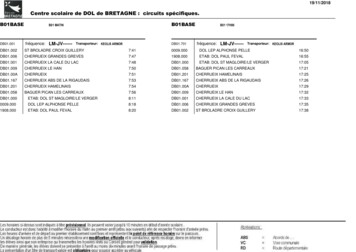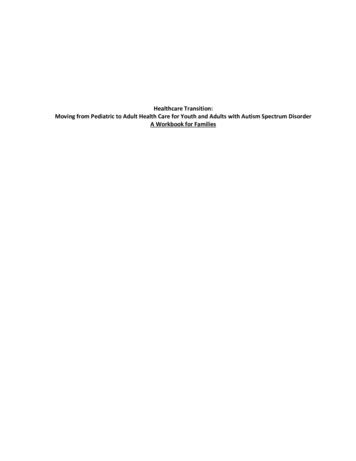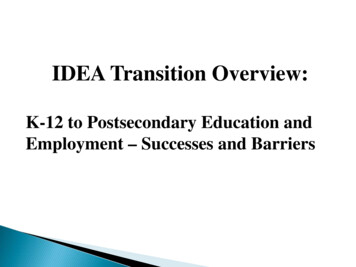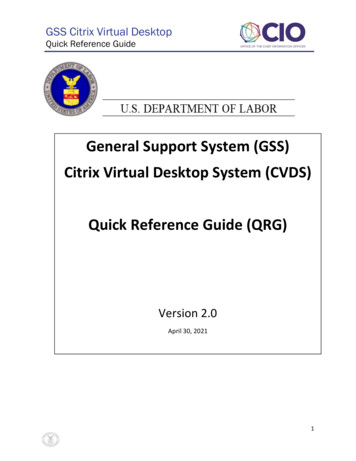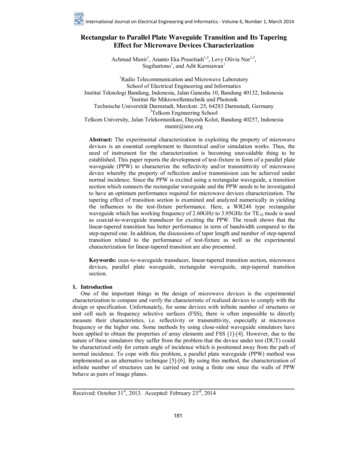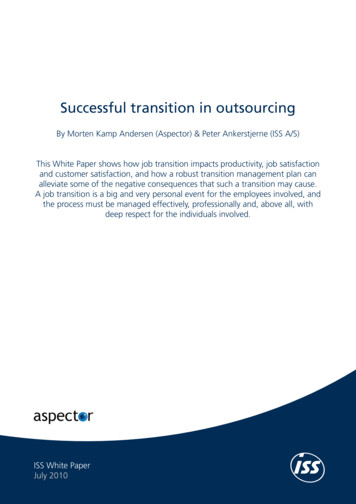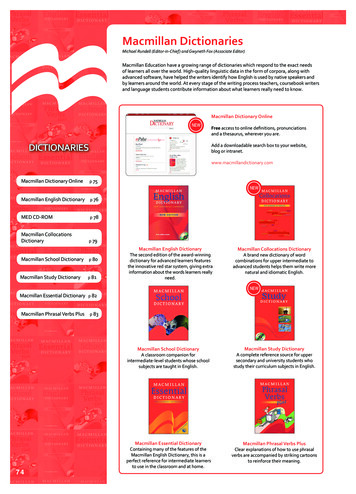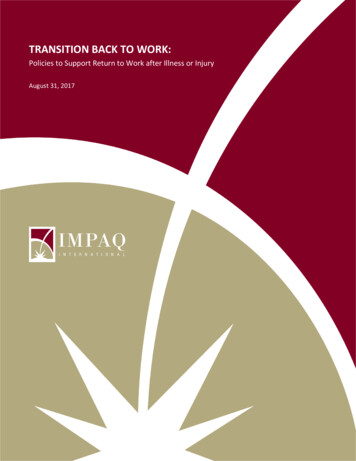
Transcription
TRANSITION BACK TO WORK:Policies to Support Return to Work after Illness or InjuryAugust 31, 2017
TRANSITION BACK TO WORK:Policies to Support Return to Work after Illness or InjuryAugust 31, 2017Authors:Joe Ashley. RhD, CRDWinthrop Cashdollar, MPPRoberta Etcheverry, CPDMKay Magill, PhD (ed.)Prepared for:U.S. Department of Labor200 Constitution Ave.Washington, DC 20210Submitted by:Linda Toms Barker, Project DirectorIMPAQ International, LLC10420 Little Patuxent Parkway, Suite 300Columbia, MD 21044www.impaqint.comCitation: Ashley, J., Cashdollar, W., Etcheverry, R., and Magill, K. (ed.) (2017). Transition Back to Work: Policies to SupportReturn to Work after Illness or Injury. For SAW/RTW Policy Collaborative, U.S. Department of Labor, Office of DisabilityEmployment Policy, IMPAQ International, LLC.Preparation of this document was funded by the Office of Disability Employment Policy, U.S. Department of Labor, Contract NumberDOLQ121A21885/DOL-OPS-16-U-001782. This document does not necessarily reflect the views or policies of the Office of DisabilityEmployment Policy, U.S. Department of Labor, nor does the mention of trade names, commercial products, or organizations implyendorsement by the U.S. government.
PREFACEThe Stay-at-Work/Return-to-Work (SAW/RTW) Policy Collaborative was established by the U.S.Department of Labor’s Office of Disability Employment Policy (ODEP) to support the developmentof policies, programs, and practices that encourage the continued employment of workers likelyto leave the workforce due to injury, serious illness, or disability. The Collaborative consists of aCommunity of Practice to provide input and real-time feedback on specific policy topics relatedto SAW/RTW, and Policy Working Groups (PWGs), led by Subject Matter Experts (SMEs) andsupported by IMPAQ International who explore policies and practices that curtail long-term workdisability and job loss due to injury and illness, provide policy recommendations to keystakeholders, and develop resources to support policy action. The 2017 PWGs focused on threetopics: (1) Replicating and Adapting the State of Washington’s Centers of Occupational Healthand Education (COHE) Model; (2) Musculoskeletal Conditions and Pain Management; and(3) Transition Back to Work. This Policy Action Paper is a product of the Transition Back to WorkPolicy Working Group, co-led by Roberta Etcheverry (SME Lead) and Kay Magill (IMPAQ Lead).Members of the Transition Back to Work Policy Working Group:Joe Ashley, RhD, CRDAssistant Commissioner for Grants and Special ProgramsVirginia Department for Aging and Rehabilitative ServicesWinthrop S. Cashdollar, MPPExecutive Director, Product PolicyAmerica's Health Insurance PlansHenry ClaypoolClaypool ConsultingCommunity Living Policy Center (CLPC), Institute for Health & AgingUniversity of California, San Francisco (UCSF)Roberta Etcheverry, CPDMPWG CO-LEADCEO, Diversified Management Group (DMG)Lisa Jordan, MS, CRC, CPDMPresident, Human Solutions LLCAlan McClain, MPACommissioner, Arkansas Rehabilitation ServicesBrian NeaseEmployment Services ManagerState of Oregon Workers’ Compensation DivisionAnn M. Shannon, JDClaims Policy ManagerOhio Bureau of Workers’ Compensation (BWC)IMPAQ International, LLCPage iTransition PWG Policy Action PaperAugust 31, 2017
TABLE OF CONTENTSPREFACE . iTABLE OF CONTENTS.iiEXECUTIVE SUMMARY .iii1.INTRODUCTION . 12.POLICY CONTEXT FOR TRANSITION BACK TO WORK . 3Multiple Complex Service Systems . 3Costs and Benefits of Transition to Employers . 5Individual Workers’ Concerns . 6Workers’ Compensation and Private Disability Insurance . 73.STRATEGIES TO SUPPORT THE RTW TRANSITION . 9Partial Return to Work . 9Partial Disability Benefits. 10Employer Subsidies and Incentives . 143.RECOMMENDATIONS . 22REFERENCES . 25GLOSSARY OF TERMS AND ACRONYMS . 29APPENDIX A. RESOURCE MAP . A-iIMPAQ International, LLCPage iiTransition PWG Policy Action PaperAugust 31, 2017
EXECUTIVE SUMMARYThis Policy Action Paper was prepared by the Transition Back to Work Policy Working Group(PWG) of the U.S. Department of Labor’s Office of Disability Employment Policy’s (ODEP’s) Stayat-Work/Return-to-Work (SAW/RTW) Policy Collaborative. In this paper, the PWG examinesstrategies to assist workers who have lost work time due to illness or injury in making thetransition back to work as early as possible in their recovery process. After an injury, illness, ordisability that causes him or her to disengage from the workforce, a worker may encounterobstacles to returning to work and continuing in their job essentially as before. The PWG focuseson partial return-to-work (RTW) strategies for those not yet able to return to full-duty at theirprevious jobs, as well as incentives for employers to ease the transition back to work throughstrategies such as light duty, reduced hours, workplace modifications, or transitional jobs.Both government and the private sector can play an important role in ensuring that obstacles toRTW are removed or minimized and that the worker’s transition back to work is made assmoothly and as quickly as possible. The Transition Back to Work PWG provides state and federalpolicymakers, as well as both public and private employers, with the following recommendationsfor policies that support for the worker’s transition back to work.1. Facilitate the development of evidence of the effectiveness of transition-back-to-workstrategies. Policies that encourage development of the knowledge base and makes thecase for programs focused on the workers’ transition back to work can help create amechanism for promoting the implementation of such programs across sectors.2. Promote coordination and collaboration among stakeholders. Developing state andlocal initiatives that involve collaboration and the leveraging of the resources of multiplegovernment agencies can be an effective way to accomplish transition-back-to-work goalsfor workers who have disengaged from the workforce due to injury, illness, or disability.Further, establishing effective collaborative relationships among state agencies, privatesector employers, insurance carriers, healthcare providers, and other stakeholdersprovides a firm foundation to support a worker’s transition back to work.3. Promote to employers the benefits of supporting transition back to work for employeeswho left the workforce due to injury, illness, or disability. State agencies focused onemployment, productivity, and rehabilitation should share information with employers inthe state that communicates the benefits of early RTW intervention, best RTW andtransition-back-to-work practices, and resources available to help employers improveRTW outcomes. A good mechanism for communicating with employers is throughIMPAQ International, LLCPage iiiTransition PWG Policy Action PaperAugust 31, 2017
intermediaries such as employer groups and associations that are in a position to establishbest practices and make resources available to their employer members.4. Provide financial incentives to employers.a. Wage subsidies to employers. By providing wage subsidies to employers for returninginjured or ill employees to transitional or partial RTW, employers will be betterpositioned to financially justify the actions in support of RTW.b. Subsidies and incentives for accommodations. Providing subsidies and incentives foremployers to implement workplace accommodations can improve their overall abilityto keep injured or ill employees working.c. Insurance premium discounts. An additional strategy to incentivize employers inreturning injured or ill employees to the workplace is to create insurance premiumdiscounts based on successful RTW.d. Funding and related resources to develop transitional RTW programs.e. Tax incentives that encourage employers to offer disability income protectioncoverage. Both employers and employees may respond to tax incentives that offer afinancial inducements and send a positive signal.5. Provide employers with technical resources. Providing resources related to jobaccommodations, along with access to accommodation and RTW experts, can giveemployers confidence that the costs will be minimized and those incurred will result insuccessful RTW.6. Encourage employers to offer, and employees to take up disability income protectioncoverage. State policymakers may consider measures, such as encouraging employers touse automatic enrollment arrangements for their disability income protection plans –with ample notice to employees regarding their right to opt out. Behavioral nudges suchas automatic enrollment, which requires employees to opt out rather than opt in, havedemonstrated positive outcomes.7. Incorporate provisions for partial disability benefit payments into temporary disabilityinsurance programs. Jurisdictions that have established temporary disability insuranceprograms should incorporate provisions for partial disability benefit payments if theyhave not done so already. Jurisdictions that are considering establishing temporarydisability insurance programs should ensure that provisions for partial disability benefitpayments are included in any program they establish.8. Implement RTW programs for state employees. RTW programs for state employees canserve as model programs for employers in the state.IMPAQ International, LLCPage ivTransition PWG Policy Action PaperAugust 31, 2017
9. At the national level, establish an executive level interagency coordinating committeeto address RTW issues. It is timely to raise federal government awareness of issuesassociated with the transition back to work, through a method frequently used by federaland state government agencies to address important matters; further, federalcoordination at the highest levels of government may spur greater coordination amongstate systems.IMPAQ International, LLCPage vTransition PWG Policy Action PaperAugust 31, 2017
1. INTRODUCTIONEvery year, millions of workers in the United States experience an injury or a serious medicalproblem or disability that causes them to leave their jobs to obtain needed medical care,rehabilitation, or simply time for recovery.1 Ideally, the time away from work is temporary andshort in duration, which minimizes the consequences of what often is a major disruption for boththe worker and the employer. However, for even a relatively brief absence from work, the workermust deal with healthcare providers, insurance companies, human resources personnel,workplace management, and other involved parties, which can be a complicated, timeconsuming, and difficult endeavor. At the same time, the employer must devote other resourcesto getting the work done without replacing the employee.When the worker is ready to transition back into the workplace such difficulties often persist. Forexample, he or she may not yet have the ability to work full-time, even with workplaceaccommodations. Or, he or she may be unable to function in the job in the same way as beforethe injury or illness. Many experts consider it critical that the worker can rely on public- andprivate-sector strategies that are designed to keep an injured or ill employee engaged with theemployer to facilitate the transition back to work and increase the likelihood that the employeewill stay in the workforce. 2This policy action paper focuses on return-to-work (RTW) strategies to assist workers in makingthe transition back to work as soon as possible and maximizing their participation in the laborforce. Strategies considered here include partial RTW; partial disability benefits, and employersubsidies and incentives. While each strategy has its individual strengths, these strategies areenhanced when implemented together.1. Partial RTW provides individuals with meaningful work that is designed to ease thetransition back to work, within an individual’s medical restrictions if necessary, and thusre-engage them in the workforce sooner than otherwise might be possible. Typical partialRTW options include modified work (such as light duty), part-time work, and transitionalor alternative work (that, for example, allows for medical restriction). During thistransitional phase, employers might train workers to take on different jobs. Partial RTWallows employees to work while they are still recovering and in some cases, may bedifferent than their regular job duties.Bardos, M., Burak, H. and Ben-Shalom, Y. (2015). Assessing the Costs and Benefits of Return-to-Work Programs.Final report submitted to the U.S. Department of Labor, Office of Disability Employment Policy. Washington, DC:Mathematica Policy Research.2International Association of Industrial Accident Boards and Commissions (IAIABC) (2016). Return to Work: AFoundational Approach to Return to Function.1IMPAQ International, LLCPage 1Transition PWG Policy Action PaperAugust 31, 2017
2. Partial Disability Benefits provide financial support to employees who transition back towork on a part-time basis or who are earning less than they did prior to their injury orillness. Temporary Disability Insurance (TDI) is mandated by some states that requireemployers to cover disability and injury for their employees. Short-Term DisabilityInsurance (STDI) may be offered to employees within an employer’s benefit package.Individuals can also purchase this insurance as a separate policy. TDI covers only nonwork-related illness or injury. STDI benefits are integrated with Workers’ Compensationbenefits.3. Employer subsidies and incentives are made available in some states to supportemployers that develop programs that transition employees back to work or hireindividuals who have a disability. Employers can also take advantage of tax credits, wagesubsidies, and even insurance discounts.RTW in general, and transition back to work in particular, have become topics of great interestto policymakers at the federal and state level. 3 In most instances, state policymakers are theprimary actors when it comes to developing policies that promote and facilitate the transitionback to work for workers who have become disengaged from the workforce due to injury, illness,or disability. Federal policymakers also have shown an interest in identifying strategies thatpromote the capacity of workers who have left the workforce to transition back to work. Otheraudiences for this policy action paper include the insurance industry, which may develop andpromote policies that support RTW within the industry, as well as medical providers, who maydevelop RTW policies, albeit at a more local level, for healthcare practitioners. Finally, individualemployers may benefit from designing policies to facilitate the transition back to work for theirown employees.3As one indication, in addition to ODEP’s creation of the SAW/RTW Policy Collaborative, the Council of StateGovernments and National Conference of State Legislatures convened a National Task Force on WorkforceDevelopment for People with Disabilities in 2016, and highlighted SAW/RTW policy options that may supportworkforce connection among workers experiencing an injury or onset of disability or changes to their disabilitystatus. See: The Council of State Governments and National Conference of State Legislators (2016). Work Matters:A Framework for States on Workforce Development for People with Disabilities.IMPAQ International, LLCPage 2Transition PWG Policy Action PaperAugust 31, 2017
2. POLICY CONTEXT FOR TRANSITION BACK TO WORKA worker’s disengagement from the workplace due to injury, illness, or disability can have majorconsequences for both the worker and the employer, not to mention the national economy andsociety at large. 4 The next section describes some of the issues that especially affect the worker’stransition back to work following such an absence.Multiple Complex Service SystemsWhen an employee experiences injury, illness, or disability that causes him or her to exit theworkforce, he or she will likely interact with, at a minimum, medical practitioners, workplacemanagers, and benefits claims administrators. These professionals have their own specializedresponsibilities and goals, which aren’t necessarily aligned with the RTW interest of either theemployer or the employee. For example, healthcare practitioners tend to focus on diagnosis andtreatment, not on functional and RTW outcomes, which have not traditionally been within thepurview of medicine.5 They are typically not trained in the benefits of RTW, and may not considerthe options that accommodations could provide a worker or have a full understanding of tasksspecific to a given job. 6 Additionally, the paperwork needed for RTW may be viewed as anunnecessary burden. 7 The workplace manager may be more concerned about how best to getthe work done in the employee’s absence than with the worker returning to work. Likewise, theclaims administrator may be more concerned with claims processing and paperwork than onworkforce attachment and the employee returning to work. Typically, there is limitedcommunication among these professionals “due to professional traditions, social and businessconventions, and organizational and infrastructure barriers.” 8Several service systems are available that workers might access to help them with RTW. Theseresources include state vocational rehabilitation (VR) agencies, the public workforce system ofAmerican Job Centers (AJCs) under the Workforce Investment Opportunity Act (WIOA), privaterehabilitation, and community-based employment programs. These service systems haveprogram strengths that can support RTW. For example, WIOA Adult and Dislocated Workerprograms are increasingly developing services that include supports for individuals withdisabilities in response to their requirements to provide equal access under the Americans with4For example, the situation that occurs when workers who are injured or who become ill leave the workforcepermanently and apply for public disability benefits, i.e., Social Security Disability Insurance (SSDI).5American College of Occupational and Environmental Medicine (ACOEM) (2008). The Personal Physician’s Role inHelping Patients with Medical Conditions Stay at Work or Return to Work.6Denne, J., Kettner, G., & Ben-Shalom, Y. (2015). The Role of the Physician in the Return-to-Work Process FollowingDisability Onset. Mathematica Policy Research.7Christian, J. (2015). Establishing Accountability to Reduce Job Loss After Injury or Illness. Mathematica PolicyResearch.8Christian, op. cit.IMPAQ International, LLCPage 3Transition PWG Policy Action PaperAugust 31, 2017
Disabilities Act (ADA), a focus that may provide an opportunity to develop RTW supports. The AJCconnection to eligible training providers can bring resources to support short-term training ifrequired for new job skills or duties. The AJCs also have resources to support incumbent workertraining and other business engagement services to support employers and RTW workers. VR hasrehabilitation counselors with training to support the adjustment, emotional support needs, andencouragement. In many states, VR resources include assistive technology and workplacemodification expertise as well as job and task analysis to assist with identifying transitionalemployment opportunities consistent with medical restrictions. There may be a need for jobcoaching resources to facilitate learning of new job duties. Also, with WIOA’s reauthorization ofVR programs, there is a new option available to VR agencies to elect to provide stay-at-workservices for workers with disabilities who are in immediate jeopardy of losing their jobs. Thisservice can be provided outside of the Order of Selection process that otherwise requires VRagencies with waiting lists to serve those with the most severe disabilities first. Adult Educationmay also provide resources to help with learning new job skills. Working through the process ofidentifying system and program strengths and then aligning them to support workers in theirtransition back to work and the businesses that employ them can become the foundation ofcreating public/private partnerships for RTW. Policies that support such actions can drive localinnovation and implementation of cross-program RTW services.It is the case that these resources are typically not accessed by workers or employers for RTWservices. One reason for this may be that resources such as the AJCs or VR are usually not engagedwith individuals who are employed at the onset of a disability, illness, or injury. By the time theyare needed for RTW assistance, there has usually been lengthy unemployment, which is not thetypical RTW situation and which involves a slower process toward regaining employment.However, once these sources of assistance have come into play, collaboration and the leveragingof the resources of multiple government agencies should be considered as a way to assist workersin their transition back to work. An increased policy focus on improving the communication andcoordination across the key players involved in RTW may be seen in the SAW/RTW PolicyCollaborative’s “Replicating and Adapting COHE Strategies” PWG, which is exploring the policyconsiderations of adopting or adapting the RTW strategies of the Centers of Occupational Health& Education (COHE), a model workers’ compensation program of the Washington Department ofLabor & Industries. 9 In both the Washington COHE model and the Colorado program designed toadapt and replicate it, there has been a focus on coordination of early communication amonginjured workers, healthcare providers, and employers; coordination of care among healthcareproviders; emphasis on functional outcomes; and incorporation of the RTW principles in allSung, D., Lore, H., Magill, K. (ed.) (2017). Improving Occupational Healthcare Delivery to Support Workers’Compensation Return to Work: Building on Evidence-Based Practice from Washington State’s Centers ofOccupational Health & Education (COHE) Experience. For SAW/RTW Policy Collaborative, U.S. Department of Labor,Office of Disability Employment Policy, IMPAQ International, LLC.9IMPAQ International, LLCPage 4Transition PWG Policy Action PaperAugust 31, 2017
aspects of the collaborative care system being developed. Another way in which agencies maycollaborate is in the production of educational materials such as the RTW guide jointly developedby California’s Division of Workers’ Compensation and its Department of Fair Employment andHousing to address both workers’ compensation and disability law as they affect transition backto work.Costs and Benefits of Transition to EmployersThe high cost to business of workers leaving the job due to injury, illness, or disability is welldocumented. 10,11 Improving the worker’s ability to transition back to work as soon as possible,helps lower the cost to business for expenses such as absenteeism, lost productivity, and, in somecases, the need to replace employees. 12 To a business, however, retaining an employee atreduced productivity or retraining him or her for another position can appear to be anunacceptable cost. Although many employers will go this route for an employee with specializedskills, and some large companies view it as cost-effective to support RTW for low-wage workersas well, not all companies have actually assessed the costs and benefits of RTW, 13 and may avoidinvesting in an RTW program on the basis of cost. Most employers would gain from consideringboth the up-front costs and the long-term benefits of establishing an RTW program, anddetermining if the benefit of a RTW program that keeps the employee outweighs the up-frontcosts (e.g., workplace modifications) as well as the cost of retaining an employee at reducedproductivity or retraining him or her for another position.One issue of concern here is that some of the costs and benefits may not be readily apparent oreven very tangible, such as increased morale for the worker (and his or her co-workers) whenaccommodations are made and supported. 14 Another issue is the misperception on the part ofsome employers that workers that are injured are malingering, seeking fraudulent opportunities,or being lazy and not interested in work. However, evidence shows the most workers wouldprefer returning to work with full benefits, especially because, far from gaining financially, theyoften receive less compensation following injury or illness than their previous salary. 1510In 2012, the Integrated Benefits Institute found that poor worker health costs employers 576 billion annually, forexpenses that include workers compensation and disability and group health programs. Of that amount, 39%, or 227 billion, results from lost productivity tied to poor worker health. See: Ceniceros, Roberto. (2012) Tracking TrueCost of Lost Productivity Remains a Challenge. Workforce.com.11U.S. Department of Labor, Occupational Safety and Health Administration (2012). Injury and Illness PreventionPrograms White Paper.12Bardos, et al., op. cit.13Loy, B. Accommodation and Compliance Series: Workplace Accommodations - Low Cost, High Impact. JobAccommodation Network (JAN).14Mitchell, K. (2012). The Return to Work Dividend: Protecting Productivity. Testimony to the US Senate Committeeon Health, Education, Labor and Pensions.15IAIABC, op. cit.IMPAQ International, LLCPage 5Transition PWG Policy Action PaperAugust 31, 2017
When considering RTW, an individual may need an accommodation to complete their work atthe same level of production as they did prior to their injury or disability. Accommodations canrange from something as simple as a magnifier to help with limited vision, to something morecomplex, and in some cases more expensive, such as modifying a work station or work processto accommodate physical or stamina limitations. Adding to the confusion for both employee andemployer is the lack of knowledge that comes with the legal responsibilities, limited knowledgeabout the true costs of accommodations, and concepts such as undue hardship which could limitthe employer’s responsibility to provide job accommodations to the employee. 16States, insurers, and employers have, in some cases, adopted policies designed to overcomethese cost challenges to RTW. In an effort to improve the return on investment to employers andencourage them to participate in RTW programs, a number of states (see Appendix A) haveadopted policies or implemented programs to provide, for example, wage subsidies,reimbursement for accommodation costs, or other financial incentives that help to offset thecosts of an RTW program. Previous work by the SAW/RTW Policy Collaborative, the Council ofState Governments, and the National Conference of State Legislatures, among others, suggeststhat employee retention strategies (including temporary partial disability and transitional workincentives), as well as incentives to stimulate private sector engagement in hiring or retainingworkers with disabilities, are potential policy options and are already being attempted in selectedstates. 17,18,19Individual Workers’ ConcernsThe Job Accommodation Network (JAN) notes that the likelihood of an injured worker returningto work drops to 50% by the 12th week of leave.20 This is a very short period of time to engagean employee who is not only adjusting to an injury/disability, but also seeking medical treatmentand navigating the myriad agencies and resources available. With this in mind, it becomesimportant to consider the many factors—both internal and external—that have a part indetermining whether an individual returns to work.After a disability, a worker not only experiences the loss of a paycheck, but may also have limitedinteraction with colleagues and can feel cut off from communication and supports. This isespecially difficult when you consider that the worker spends most of their time at the worksite16National Center on Secondary Education and Transition (NCSET). Employment Supports & Accommodations –Frequently Asked Questions.17Ben-Shalom, Y., Bruns, S., Contreary, K., & Stapleton, D. (2017). Stay-at-Work/Return-to-Work: Key Facts, CriticalInformation Gaps, and Current Practices and Proposals. Mathematica Policy Research.18The Council of State Governments (2016). Workforce Development Efforts for People with Disabilities: Hiring,Retention and Reentry.19National Conference of State Legislatures (201
employment, productiv ity, and rehabilitation should share information with employers in the state that communicates the benefits of early RTW intervention, best RTW and transition-back-to-work practices, and resources available to help employers improve RTW outcomes. A good mechanism for communicating with employers is through
